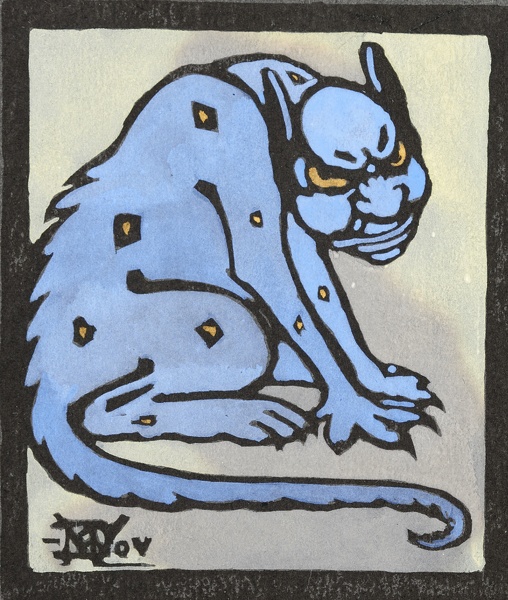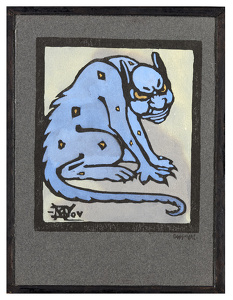

 Hover over the painting to magnify (there may be an initial delay while the magnified image is loaded)
Hover over the painting to magnify (there may be an initial delay while the magnified image is loaded)Marion Wallace Dunlop (1864-1942):
A Glaring Demon, (blue and yellow) from Devils in Diverse Shapes, circa 1906
Passe-partout (ref: 10127)
Signed with monogram, titled to reverse
Hand coloured woodcut
See all works by Marion Wallace Dunlop print woodcut allegory 1.Master Designs 49 pictures Rediscovering Women Artist WOMEN
Provenance: Private collection
Marion Wallace-Dunlop exhibited her series of roaring and grinning ‘Devils in Divers Shapes’ at John Baillie’s Gallery, London, in 1905. A review in The Studio, while admiring the originality and inventiveness of the prints, considered, nevertheless, that ‘a feminine belief in the pretty is often apparent in them’. Knowledge of the artist’s biography, which included daring protests for the women’s suffrage movement, suggests a wider range of thematic and emotional content.
Trained at the Slade School of Fine Art, by the 1890s Wallace-Dunlop was enjoying a successful career as a painter and illustrator. After 1900, however, she turned her classical training to the service of the militant women’s suffrage movement, joining the Central Society for Women’s Suffrage, the Fabian Women’s Group and the Women’s Social and Political Union, for whom she organized and designed a series of spectacular processions. After being arrested for militancy in 1909, she became the first British suffragette to go on hunger strike.
With its intense glare, sharp claws and whip-like tail, this almost-amphibious and androgynous creature is perhaps the most menacing of the Devils series. In 1867, the writer and social criticThomas Carlyle termed universal suffrage the “Devil- appointed way” to count heads. In this context, it is easy to imagine that Wallace-Dunlop fully intended for her devils to be the very incarnation of a sense of outrage at the injustices to which women were subjected.
Literature: Llewellyn, Sacha, et al. Women Only Works on Paper. Liss Llewellyn, 2021, p. 11.



 Unsung Heroines
Unsung Heroines Privately held
Privately held




